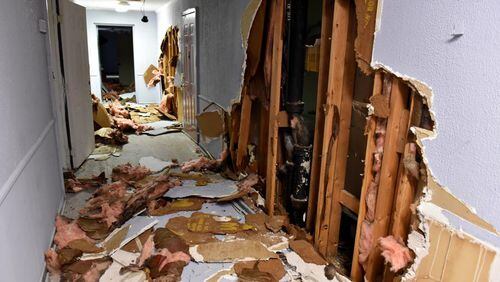Amid holiday travels, you may have missed the excellent piece by my AJC colleague Ty Tagami on whether the extra state dollars proposed for poor Georgia students are enough to make a difference.
The story appears in Thursday's print AJC, but can also be read on MyAJC.com.
Tagami frames the spending question against the backdrop of DeKalb's Flat Shoals Elementary. The south DeKalb school would have been a candidate for state takeover had voters approved Gov. Nathan's Deal proposed Opportunity School District last month. Voters resoundingly rejected the effort to empower the governor to transfer failing schools into a state-run district but without the promise of any additional funding.
Many critics of public education contend more money doesn't matter but new research challenges that contention. A recent National Bureau of Economic Research study compared state spending starting in 1990 and found increased funding improved student outcomes.
Harnessing little-used data from the National Assessment of Educational Progress and comparing states that increased funding for their poorest schools with those that did not, researchers found,"Using nationally representative data on student achievement, we find that this spending was productive: Reforms increased the absolute and relative achievement of students in low-income district."
Certainly, schools that serve a large number of low-income students face far greater challenges. For example, when a trash and crime ridden apartment complex in its attendance zone was deemed uninhabitable in September, Flat Shoals Elementary expected 10 or fewer of its students would be affected, according to Tagami's news story.
It turned out 50 students were residing with their families in the abandoned complex where the leasing office had been closed for months, rent was no longer collected, mail was not delivered and power was off in many units.
Tagami reports:
Flat Shoals and other schools packed with poor students highlight a challenge for teachers as poverty rises outside school doors: how to provide extras services that can put the poorest students on a stable footing so they can learn. It's a foreign problem for middle-class schools, but politicians across Georgia will likely have to grapple with it when the General Assembly starts Jan. 9. Gov. Nathan Deal is expected to propose a sweeping overhaul of the state's decades-old school funding formula, with differing implications for schools based on the number of low-income households they serve.
Though Deal hasn't divulged his legislative plans, a commission he empanelled in 2015 to study school funding issued a proposal that gives additional dollars to school districts based on the number of "economically disadvantaged" students they enroll.
But observers such as Claire Suggs, a policy analyst with the Georgia Budget and Policy Institute, a watchdog non-profit, questions the formula's adequacy. It would apply to only about half the more than 60 percent of Georgia students who currently qualify for subsidized school breakfasts and lunches. And Suggs said the 10 percent in additional dollars per poor student in the formula wasn't based on an analysis of the cost to provide services.
There's little information about what the price tag should be. "There've been very few empirical studies that are sound that have been able to look at those expenditures for 'wraparound' services, as they are called," said Gary Henry, a professor at Vanderbilt University. He analyzes school turnaround efforts, and he said it probably costs twice as much to adequately educate a child in poverty as a typical middle-class kid — far more than the 10 percent extra that Deal's Education Reform Commission recommended.
Given the dire circumstances of students at Flat Shoals Elementary and other high-poverty schools, what is the right funding approach?
I told a friend about the triage Flat Shoals Elementary had to provide when its families were forced out of the dilapidated apartment complex. Shocked that adults allowed young children to live in such squalid conditions, she wondered, "Can there ever be enough money for schools to overcome what these kids endure every day?"
About the Author



/cloudfront-us-east-1.images.arcpublishing.com/ajc/P7DYBH6TO7FEKG4SUXQQKADRXE.jpg)



